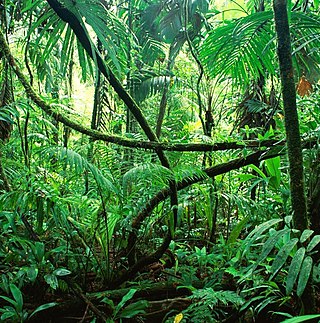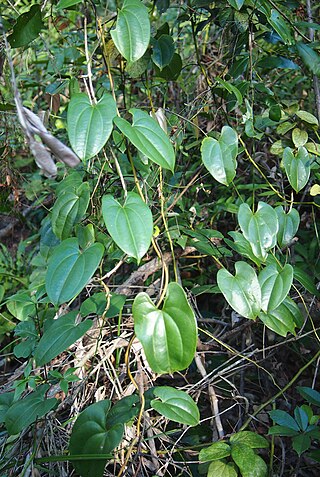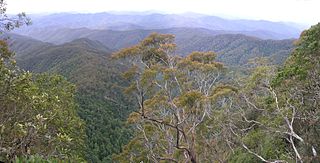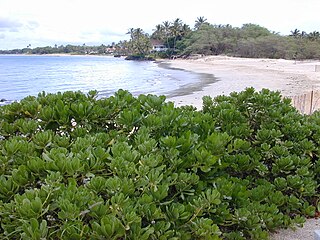
Rainforests are forests characterized by a closed and continuous tree canopy, moisture-dependent vegetation, the presence of epiphytes and lianas and the absence of wildfire. Rainforests can be generally classified as tropical rainforests or temperate rainforests, but other types have been described.

Conway is a national park in Queensland, Australia, 911 km northwest of Brisbane. The park's main feature is the Conway Peninsula which is covered by the largest area of lowland tropical rainforest in Queensland outside Tropical North Queensland.

Tropical and subtropical moist broadleaf forests (TSMF), also known as tropical moist forest, is a subtropical and tropical forest habitat type defined by the World Wide Fund for Nature.

The Queensland tropical rain forests ecoregion covers a portion of the coast of Queensland in northeastern Australia and belongs to the Australasian realm. The forest contains the world's best living record of the major stages in the evolutionary history of the world's land plants, including most of the world's relict species of plants from the ancient supercontinent of Gondwana. The history of the evolution of marsupials and songbirds is also well represented.

Mount Bartle Frere is the highest mountain in Queensland at an elevation of 1,611 metres (5,285 ft). The mountain was named after Sir Henry Bartle Frere, a British colonial administrator and then president of the Royal Geographical Society by George Elphinstone Dalrymple in 1873. Bartle Frere was British Governor of Cape Colony at the outset of the Anglo-Zulu War.

Tropical rainforests are rainforests that occur in areas of tropical rainforest climate in which there is no dry season – all months have an average precipitation of at least 60 mm – and may also be referred to as lowland equatorial evergreen rainforest. True rainforests are typically found between 10 degrees north and south of the equator ; they are a sub-set of the tropical forest biome that occurs roughly within the 28-degree latitudes. Within the World Wildlife Fund's biome classification, tropical rainforests are a type of tropical moist broadleaf forest that also includes the more extensive seasonal tropical forests.
Allosyncarpia ternata, commonly known as an-binik, is a species of rainforest trees constituting part of the botanical family Myrtaceae and included in the eucalypts group. The only species in its genus, it was described in 1981 by Stanley Blake of the Queensland Herbarium. They grow naturally into large, spreading, shady trees, and are endemic to the Northern Territory of Australia. They grow in sandstone gorges along creeks emerging from the Arnhem Land plateau.

Dioscorea transversa, the pencil yam, is a vine of eastern and northern Australia.

The Eastern Australian temperate forests is a broad ecoregion of open forest on uplands starting from the east coast of New South Wales in the South Coast to southern Queensland, Australia. Although dry sclerophyll and wet sclerophyll eucalyptus forests predominate within this ecoregion, a number of distinguishable rainforest communities are present as well.

The Arnhem Land tropical savanna is a tropical and subtropical grasslands, savannas, and shrublands ecoregion in Australia's Northern Territory.

The Kimberley tropical savanna is a tropical and subtropical grasslands, savannas, and shrublands ecoregion in northwestern Australia, covering portions of Western Australia and the Northern Territory south of the Timor Sea.

Austrosteenisia blackii is a leguminous liana of the rainforests and dry rainforests of tropical and sub-tropical eastern Australia. Also known commonly as the blood vine for the dark red sap that exudes from cut stems. Blooms resemble dark red peas and produce papery fruit up to 12 cm long with kidney-shaped seeds. It is a vigorous creeper and can be used as ground cover in gardening. It is spectacular in bloom from September to December.

Dolichandra unguis-cati, commonly known as cat's claw creeper, funnel creeper, or cat's claw trumpet, is a rapidly growing climbing vine belonging to the family Bignoniaceae. It affects all plant layers of the forest ecosystem spreading rapidly both vertically and horizontally.

Tropical vegetation is any vegetation in tropical latitudes. Plant life that occurs in climates that are warm year-round is in general more biologically diverse that in other latitudes. Some tropical areas may receive abundant rain the whole year round, but others have long dry seasons which last several months and may vary in length and intensity with geographic location. These seasonal droughts have great impact on the vegetation, such as in the Madagascar spiny forests.

Oxera splendida is an evergreen vine in the family Lamiaceae which produces white, fragrant flowers and white, egg-shaped fruit. It naturally is occurs in the tropical rain forests of tropical Asia and Australia and is often sighted along rain forest margins such as roads. Some common names include October Glory, Glory Vine, Potato Vine and Fragrant Faradaya. Australian indigenous names include Garanggal used from Cairns to Yarrabah, Buku used in the Tully River area, Koie-yan used at Dunk Island and Djungeen used by the Girramay clan.

Seasonal tropical forest, also known as moist deciduous, semi-evergreen seasonal, tropical mixed or monsoon forest, typically contains a range of tree species: only some of which drop some or all of their leaves during the dry season. This tropical forest is classified under the Walter system as (i) tropical climate with high overall rainfall and (ii) having a very distinct wet season with dry season. These forests represent a range of habitats influenced by monsoon (Am) or tropical wet savannah (Aw) climates. Drier forests in the Aw climate zone are typically deciduous and placed in the Tropical dry forest biome: with further transitional zones (ecotones) of savannah woodland then tropical and subtropical grasslands, savannas, and shrublands.
Australian Tropical Rainforest Plants, also known as RFK, is an identification key giving details—including images, taxonomy, descriptions, range, habitat, and other information—of almost all species of flowering plants found in tropical rainforests of Australia, with the exception of most orchids which are treated in a separate key called Australian Tropical Rainforest Orchids. A key for ferns is under development. RFK is a project initiated by the Australian botanist Bernie Hyland.
Typhonium alismifolium is a species of plant in the arum family that is endemic to Australia.

Rainforests and vine thickets are a major vegetation group in Australia. It consists of temperate to tropical rainforests, monsoon forests, and vine thickets. Rainforests and vine thickets are generally found in small pockets across the eastern and northern portions of the continent, including western Tasmania, eastern New South Wales, eastern Queensland, the northern portion of the Northern Territory, and the Kimberley Region of northeastern Western Australia.

















